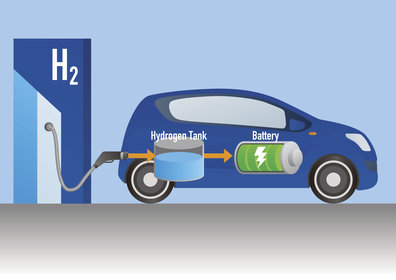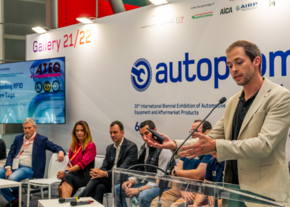
21/05/2017
Hydrogen-powered cars, a future 1,000 billion dollar automotive business
Dino Collazzo
According to a research published by Information Trends, in 2032 vehicles powered by hydrogen fuel cells could amount to as many as 22.2 million. But reaching these volumes will largely depend on investments in innovation and technologies aimed at breaking down the production costs of hydrogen and create a capillary network of refueling stations.
Hydrogen cars are “fueling” the debate among automotive experts who consider fuel cell vehicles the future of the sector. For now, however, the engines are still off. Several factors, in fact, are slowing down the development from a few prototypes in circulation to a large-scale distribution. These factors range from production costs that are still too high, to the difficulty of producing hydrogen fuel in an efficient and sustainable manner. If, in the past, this would have had a negative influence on the development of these eco-friendly vehicles, now they are actually driving investments in research and innovation. And this thanks not only to the desire of traditional manufacturers to improve their vehicles performance reducing fuel consumption and emissions at the same time. New industrial players – mostly from the hi-tech sector – have set their sights on this new "green strategy".
According to a research published in Information trends, and related to the potential development of hydrogen vehicles, in 2016 2,500 hydrogen cars were sold worldwide. Three times more compared to 2015. Of course, in terms of volumes (sales and leases), these figures can hardly be compared to the rest of the automobile sector. Yet still sufficient, according to several analysts, to represent a trend destined to grow in the coming years, to the point that many are imagining for the future a "hydrogen economy". The researchers involved in the study estimated that between now and 2032, the volume of hydrogen fuel cell vehicles sold and rented throughout the planet could amount to as many as 22.2 million units able to generate a total revenue of 1,000 billion dollars for the entire automotive sector and its supply chain. The reference markets are the ones proving to be already the most prosperous, with Asia holding a share of 48%, Japan leading the ranking of countries with the largest number of vehicles of this type, and North America, with a share of 43% – with California taking the lion’s share –. Far behind we find Europe which scores a mere 9%.
However, in order to increase volumes, new infrastructures are required if the objective is to promote a greater diffusion of hydrogen powered vehicles. Fundamental in this respect is the creation of production, storage and refueling facilities, and now also public institutions have started to pay the necessary attention to these developments. An example of this is the Dafi European Directive. This provision, recently adopted also in Italy, includes hydrogen among alternative fuels thus giving an impetus to the creation and subsequent growth of its own supply chain. Hydrogen, in fact, is not found free in nature but always combined with other elements – with carbon in hydrocarbons and with oxygen in water – and needs to be split to be used. The separation process can take place through different methods: electrolysis, solar irradiation, chemical reaction or pyrolysis (thermochemical decomposition of organic material at high temperatures).
For the time being, the most widely used method, due to its cost effectiveness, is steam reforming of natural gas, but the drawback is that it generates CO2 as a byproduct. This method alone – others take advantage of renewable sources or zero-impact elements, but are still far too expensive for now – generates 60% of the hydrogen used at international level, with an average natural gas efficiency of 65%. Basically, natural gas and steam react at high temperatures with the result of producing a mixture called syngas. Making the production of hydrogen cost effective improving, at the same time, engine performances and containing purchasing costs through a capillary network of refueling stations are the challenges facing the diffusion of this technology. The journey towards a hydrogen-based economy, though, has just started.
According to a research published in Information trends, and related to the potential development of hydrogen vehicles, in 2016 2,500 hydrogen cars were sold worldwide. Three times more compared to 2015. Of course, in terms of volumes (sales and leases), these figures can hardly be compared to the rest of the automobile sector. Yet still sufficient, according to several analysts, to represent a trend destined to grow in the coming years, to the point that many are imagining for the future a "hydrogen economy". The researchers involved in the study estimated that between now and 2032, the volume of hydrogen fuel cell vehicles sold and rented throughout the planet could amount to as many as 22.2 million units able to generate a total revenue of 1,000 billion dollars for the entire automotive sector and its supply chain. The reference markets are the ones proving to be already the most prosperous, with Asia holding a share of 48%, Japan leading the ranking of countries with the largest number of vehicles of this type, and North America, with a share of 43% – with California taking the lion’s share –. Far behind we find Europe which scores a mere 9%.
However, in order to increase volumes, new infrastructures are required if the objective is to promote a greater diffusion of hydrogen powered vehicles. Fundamental in this respect is the creation of production, storage and refueling facilities, and now also public institutions have started to pay the necessary attention to these developments. An example of this is the Dafi European Directive. This provision, recently adopted also in Italy, includes hydrogen among alternative fuels thus giving an impetus to the creation and subsequent growth of its own supply chain. Hydrogen, in fact, is not found free in nature but always combined with other elements – with carbon in hydrocarbons and with oxygen in water – and needs to be split to be used. The separation process can take place through different methods: electrolysis, solar irradiation, chemical reaction or pyrolysis (thermochemical decomposition of organic material at high temperatures).
For the time being, the most widely used method, due to its cost effectiveness, is steam reforming of natural gas, but the drawback is that it generates CO2 as a byproduct. This method alone – others take advantage of renewable sources or zero-impact elements, but are still far too expensive for now – generates 60% of the hydrogen used at international level, with an average natural gas efficiency of 65%. Basically, natural gas and steam react at high temperatures with the result of producing a mixture called syngas. Making the production of hydrogen cost effective improving, at the same time, engine performances and containing purchasing costs through a capillary network of refueling stations are the challenges facing the diffusion of this technology. The journey towards a hydrogen-based economy, though, has just started.






